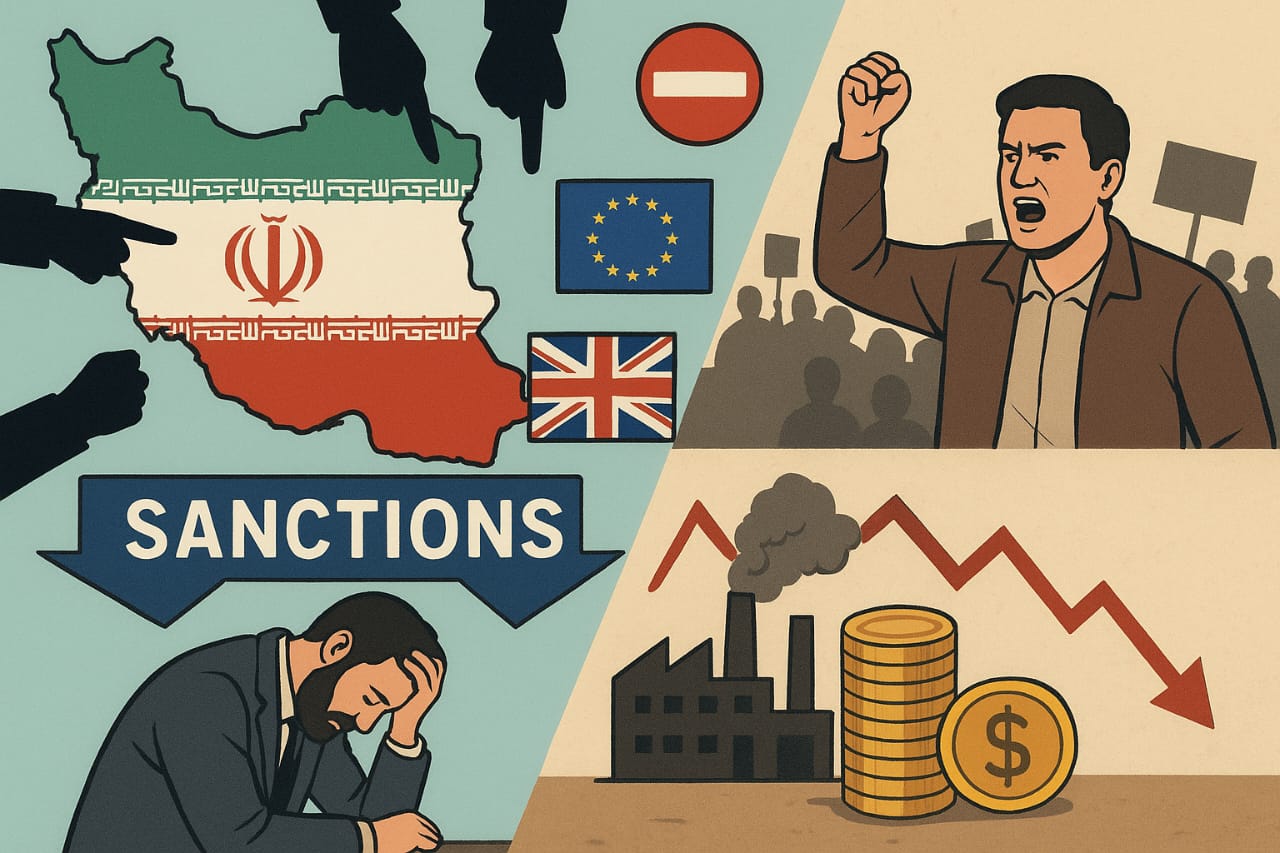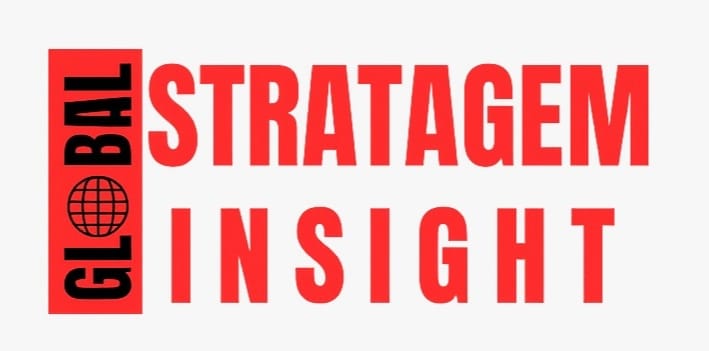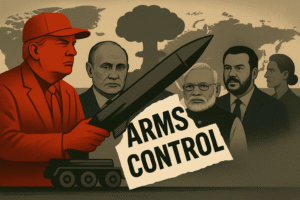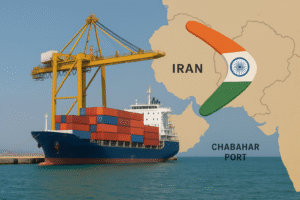International Sanctions on Iran; Domestic Impact and Counter Strategy

Caption: Sanctions imposed by global powers have led to economic struggles and domestic unrest in Iran, sparking debates on counter strategies.
When we think of a sanctions and a state whose all sectors are disrupts by the sanctions then the state come to to our mind immediately is Iran that is under the pressure of heavy sanctions imposed by European countries. A sanction is defined as “a strong action taken to force people to obey a law or rule, or a punishment meted out when they do not obey.” [1]Economic sanctions are imposed on Iran. International entities, particularly the United States, implemented harsh trade and financial sanctions to influence Iran’s behavior. The goal of these sanctions was to limit Iran’s actions connected to terrorism, nuclear weapons, and human rights violations. Embargoes, trade bans, and financial fines are among the consequences.
Iran’s journey to become sanctioned began with the Islamic revolution of 1979 where sanctions imposed on Iran to pressurize him in order to release the U.S Embassy staff taken as hostage. The sanctions of 1980s and 1990s are in response to Iran’s support to the militias in act of terrorism. Iran began nuclear enrichment in the 1980s, but the news exploded in the 2000s, and two Iranian locations were designated as nuclear sites. This enhanced the international community’s security concerns, as well as Iran’s objectives, as Iran was a signatory to the NPT. As a result, sanctions were imposed on Iran. Iran’s president, Mahmoud Ahmadinejad, took a more harsh and confrontational approach to foreign affairs in 2005.
In mid 2006 U.N Security Council launched multinational sanctions to prevent trade with Iran in good, services and technology in order to press Iran to limit its nuclear activities. In 2015, Iran and the P5+1 reached a Joint Comprehensive Plan of Action to address Iran’s nuclear programme in accordance with NPT Article VI. According to this article of NPT each of the Parties to the Treaty undertakes to pursue negotiations in good faith on effective measures relating to cessation of the nuclear arms race at an early date and to nuclear disarmament, and on a treaty on general and complete disarmament under strict and effective international control. [2]
This Plan sought to constrain Iran’s nuclear programme in exchange for sanctions relief. o implement the United States’ commitments under the JCPOA, the Obama Administration revoked sanctions-related executive orders and exercised the authority to waive or lift sanctions related to Iran’s nuclear program which the United States had imposed pursuant to various statutes. [3]
Water at the Crossroads: The Potential for Conflict and Cooperation for Iran and Afghanistan
In 2018 the Trump administration withdrew from the JCPOA because of limited duration of the certain restrictions and Iranian involvement in different malign activities. considering all this U.S ceased participation in JCPOA and re-imposed sanctions on Iran to further narrow down the activities of Iran and to shatter down the economy of the country. When Biden came to power the Biden Administration tried to revive JCPOA but the talks broke down in mid 2022.
In June 2023 the media reports show that the U.S and Iran initiated diplomatic engagements and reached to the point of unwritten agreement to release tension between them. In July 2023 the secretary of the Stated that there is no agreement going on between Iran and U.S. The recent drone and missile attack on Israel by Iran aggravated the tension between U.S and Iran. U.S defended the Israel and Whitehouse held Iran accountable and impose new sanctions and export controls on Iran. The sanctions target leaders and entities connected to the Islamic Revolutionary Guard Corps, Iran’s Defense Ministry, and the Iranian government’s missile and drone program that enabled this brazen assault. [4]
After reading the history of international sanctions on Iran several questions take birth in the mind what are the impacts of those sanctions on Iran? Was the US successful in its mission of becoming Iran an obedient country that left its nuclear program? How Iran is surviving despite sanctions for decades? What are the strategies Iran adopted to counterbalance the effect of those sanctions? This article will address the domestic impact of those sanctions. How the people of Iran bear the burden of sanctions and how the Iranian administration manages to facilitate the people and statecraft.
The United States and European Union put heavy sanctions on Iran not only the Iranian nationals but also the non-nationals that are dealing with the sanctioned Iran. The purpose is only to isolate Iran and to disturb the economy of the country so that the Iran economy could not support its nuclear program and the militant groups present in different countries of the Middle East like Hezbollah and Hamas. The sanctions were imposed on different sections of The restrictions limit Iran’s financial banking system’s ability to appraise the worldwide financial system, limit foreign investment in Iran’s banking sector, and prohibit transactions with specific Iranian banks and financial entities. In addition, the US targeted individuals and businesses implicated in illegal financial actions to promote Iran’s nuclear programme.
The oil industry has been particularly hard hit by the sanctions. Iran’s reliance on oil is at its peak, and before 2012, half of its revenue was derived by oil exports, but sanctions hindered oil exports. It also targeted foreign firms that would provide energy-related services and investment, such as investment in oil and gas fields, sales of refining equipment, and participation in activities related to oil export, such as shipbuilding, port operations, and transport insurance.
Trade was one of the other areas affected by the restrictions. All European countries terminated commercial ties with Iran, while the United States advised other countries not to do the same. The United States barred all US and European corporations from investing in Iran. The Iran-Iraq Arms Nonproliferation Act of 1992 asks for sanctions against anybody or institution that aids Tehran in the development or acquisition of “chemical, biological, nuclear, or destabilising numbers and types of advanced conventional weapons.” After 2001, the United States blocked Iran’s assets, claiming that Iran was funding terrorists.
The sanctions demonstrate the international community’s pressure on Iran to survive as a local and regional force. Sanctions affect all aspects of the state, whether they are economic, political, cultural, or social. The exploratory aspect of this piece illustrates how international sectors have impacted Iran’s internal arena. Since 2005, the United States, the United Nations, and the European Union have placed international sanctions on Iran for its nuclear programme. These sanctions have led unemployment and prices to surge, wreaking havoc on Iran’s economy. The handmade Persian rug business has also suffered as a result of US sanctions. The sanctions aimed to prevent Iran from obtaining nuclear-related materials and put an economic vise on the Iranian government to compel it to end its uranium enrichment program and other nuclear-weapons-related efforts.
The combination of unilateral sanctions and over-compliance has constituted a serious threat to human rights in Iran,[5] including the preservation and further development of essential infrastructure, difficulties in expanding social support programs, impediments in business and industrial development, deterioration of environmental security, challenges regarding natural disaster prevention, response and recovery, rising challenges in the operations of international and local non-governmental organizations and humanitarian actors, obstacles to Iran’s engagement in international cooperation, and its overall engagement with international organizations and associations due to travel bans and the inability to process payments of membership fees.
US sanctions against Iran are harming the ecology of the nation, denying migrants and Afghan refugees there access to their basic rights to health and life, and causing other issues including increased air pollution. The sanctions prevent Iranians from accessing online databases and courses concerning environmental concerns and sustainability, as well as preventing Iranian experts from participating in collaborative environmental research initiatives overseas. [6] Environmental progress in Iran is being impeded by the consequences of the sanctions on the right to education and the right to profit from scientific advancement.
Iran was one of the countries subject to harsh sanctions until Russia surpassed it by declaring war on Ukraine. There must be some explanation why Iran continues to hold firm despite being extensively sanctioned. what are some strategies that Iran adopted in order to nullify the affects of sanctions. Firstly to deal with the US and European alliance Iran increase its influence in the region. Tehran’s motivations evolved during each conflict. Iran began with primarily defensive goals of defending allies and preserving the axis, and then transitioned to offensive goals against Israel, the United States, and Saudi Arabia.[7]
In order to rising Iran’s influence Iran took part in every regional conflict either it is Iran’s intervention in Syrian civil war, Role of Iran in Iraq and Yemen civil war where Iran provide strategic and financial support to Houthi’s, a rebel group fighting against the government in Yemen. Iran supported the militias in the countries where there is US friendly government is present and the group turned into proxy from ally. To become the major actor in the region Iran is still supporting Hezbollah, Hamas, Houthis and other paramilitary groups on its full swing. These groups are the source of getting Iranian’s objective.
Iran has sought to minimise its reliance on Western countries by establishing commercial links with other countries, particularly those in Asia. It covers China, Russia, India, Turkey, and the African coast. Iran signed a 25 year strategic partnership agreement with China that will help to boost Iran economy and security domain. Iran also become a part of Chinese BRI project. China is the major importer of oil and their policies are anti-America so in case of sanctioned Iran it is the best option for Iran to export oil to China. Iranian government use the concept of wire stripping in order to get dollar from Iranian living in other countries. Iran do not recognize dual nationality but for the purpose of getting dollar to cope up with the destructive affects of sanctions Iran allow dual nationality to the high profile businessmen. [8]
Trading in dollar is the major issue for Iran at the time of heavy sanctions so the strategy used by Iran to counter this issue is the barter system and trading in their own currency. China is the major importer of Iranian oil and he imports in Yuan. By adopting barter trade and non-dollar transactions, Iran has been able to maintain a level of international trade despite the severe restrictions imposed by U.S. sanctions. These strategies provide essential economic lifelines, allowing Iran to acquire goods and maintain its export revenue streams.
Barter trade involves exchanging goods or services directly without using money. This method allows Iran to continue trading despite restrictions on financial transactions.
Iran and Russia have engaged in barter agreements where Iran supplies crude oil to Russia in exchange for Russian goods, such as machinery, agricultural products, and other commodities.[9] This helps Iran sell its oil and acquire necessary goods without involving cash transactions that could be blocked by sanctions.
Before India halted its imports of Iranian oil due to sanctions, the two countries had arrangements where Iran received goods like rice, tea, and pharmaceuticals in exchange for oil. This setup bypassed the need for dollar transactions and mitigated the impact of sanctions on Iran’s oil revenue.
Non-dollar transactions involve conducting trade using currencies other than the U.S. dollar, thereby avoiding the U.S. financial system and the scrutiny that comes with it.Iran has increasingly turned to the Euro and other local currencies for its trade. For instance, trade with the European Union is conducted in Euros, which are less affected by U.S. sanctions compared to dollar transactions. Similarly, Iran has used the Chinese Yuan and Indian Rupee in its trade with China and India, respectively.
The European Union established INSTEX to facilitate non-dollar trade with Iran, particularly for humanitarian goods such as food and medicine, which are ostensibly exempt from sanctions.[10] INSTEX allows European companies to trade with Iran without direct money transfers that would involve the U.S. financial system.
With U.S. sanctions threatening to cut off Iranian banks from the SWIFT financial messaging system, Iran has explored alternatives like Russia’s SPFS (System for Transfer of Financial Messages) and China’s CIPS (Cross-Border Interbank Payment System). [11] These systems enable international transactions without using the U.S. dollar or involving U.S. financial institutions.
Iran has also shown interest in cryptocurrencies as a way to bypass traditional banking channels. For example, Iranian businesses have used Bitcoin to pay for imports and receive payments for exports. The decentralized nature of cryptocurrencies makes it difficult for sanctions to block these transactions effectively.
To mitigate the impact of sanctions, Iran has significantly focused on boosting domestic production and achieving self-sufficiency in various sectors. This strategy aims to reduce reliance on imports, create local jobs, and stabilize the economy despite external pressures.
Iran has invested heavily in its agricultural sector to ensure food security and reduce the need for imported foodstuffs. Iran has achieved self-sufficiency in wheat production over recent years. [12] The government supports local farmers through subsidies, guaranteed purchase prices, and investments in agricultural infrastructure. This ensures a stable domestic supply of wheat, a staple food in Iran.
To optimize resource use and increase yield, Iran has expanded greenhouse farming. This method allows for the efficient use of water and space, and the production of high-value crops such as tomatoes, cucumbers, and bell peppers, which can be sold domestically or exported.
Iran has been developing its manufacturing and industrial sectors to produce goods locally that were previously imported. Iran has a substantial domestic automobile industry, producing cars, buses, and trucks. Companies like Iran Khodro and SAIPA manufacture a range of vehicles, reducing dependence on foreign car imports. Additionally, Iran has been developing and producing automotive parts locally.
Iran has expanded its petrochemical sector, adding value to its vast oil and gas resources. By producing petrochemical products domestically, Iran not only reduces the need for imports but also generates significant export revenue. For instance, Iran has developed facilities to produce plastics, fertilizers, and various chemical products.
Investments in technology and innovation are part of Iran’s strategy to enhance self-sufficiency and foster economic resilience. Iran has increased the production of domestic electronics and home appliances, such as refrigerators, washing machines, and air conditioners. Local companies like Esfahan Steel Company and Pars Khazar produce a wide range of goods, reducing the need for imports from countries that support sanctions.
Iran has made significant advancements in its pharmaceutical industry, producing a substantial portion of its medicines locally. This includes the development of generic drugs and even vaccines, which are crucial for maintaining public health and reducing dependence on imported pharmaceuticals.
To lessen the reliance on imported energy technologies and to combat the effects of sanctions on the energy sector, Iran has been investing in renewable energy. Iran has been developing solar and wind energy projects to diversify its energy sources. By harnessing its abundant solar and wind resources, Iran aims to produce a significant portion of its electricity from renewable sources, thereby reducing the need for imported energy technologies and fossil fuels.
Iran has also invested in hydropower, constructing dams and hydroelectric power plants to utilize its water resources efficiently. This development supports local energy needs and provides a sustainable and renewable energy source. Through these initiatives, Iran aims to enhance its economic resilience by reducing dependency on imports, fostering local industries, and promoting technological innovation. These efforts are critical for maintaining economic stability and mitigating the adverse effects of international sanctions. [13]
In order to avoid earlier sanctions, Iran has relied on neighboring countries such as Afghanistan and Iraq. Iran has participated in negotiations and diplomacy with the international community, which resulted in the signature of the Joint Comprehensive Plan of Action (JCPOA) in 2015.
These counter-strategies have allowed Iran to lessen the impact of international sanctions. It is crucial to note, however, that the efficacy of these techniques may fluctuate over time and in response to shifting geopolitical realities.
Dieter F. Uchtdorf said, “It’s your reaction to adversity, not the adversity itself that determines how your life’s story will develop”. Iran’s standing as a major key actor in the Middle East only because of its policies and strategies in response to the international sanctions. Iran proved that no one can beat you if you have firm believe on yourself. Now the standing position of Iran in the International arena is a true example of it.
[1] “Sanction | English Meaning – Cambridge Dictionary.” Cambridge Dictionary. Accessed May 30, 2024. https://dictionary.cambridge.org/dictionary/english/sanction.
[3] Thomas, Clayton. U.S. sanctions on Iran – CRS Reports, July 20, 2023. https://crsreports.congress.gov/product/pdf/IF/IF12452.
[4] The United States Government. (2024, April 18). Statement from president Joe Biden on Iran Sanctions. The White House. https://www.whitehouse.gov/briefing-room/statements-releases/2024/04/18/statement-from-president-joe-biden-on-iran-sanctions/
[5] Iran: Unilateral sanctions and overcompliance constitute serious threat to human rights and dignity – UN expert | Ohchr, May 19, 2022. https://www.ohchr.org/en/press-releases/2022/05/iran-unilateral-sanctions-and-overcompliance-constitute-serious-threat-human.
[6] “Iran: US Sanctions Violating Human Rights of All Living There, Say UN Experts | UN News.” United Nations, December 20, 2022. https://news.un.org/en/story/2022/12/1131887.
[7] Katz, Brian. “Axis Rising: Iran’s Evolving Regional Strategy and Non-State Partnerships in the Middle East.” Center for Strategic & International Studies, October 11, 2018. https://www.csis.org/analysis/axis-rising-irans-evolving-regional-strategy-and-non-state-partnerships-middle-east.
[8] Cavan, Susan. “How Iran Will Cope with US Sanctions.” Atlantic Council, October 5, 2021. https://www.atlanticcouncil.org/in-depth-research-reports/issue-brief/how-iran-will-cope-with-us-sanctions/.
[9] Khajehpour, Bijan. “Will Barter Arrangements Revive Iran’s Sanctioned Economy?” Amwaj.media, July 15, 2022. https://amwaj.media/article/will-barter-arrangements-revive-iran-s-sanctioned-economy.
[10] Winter, Chase. “What Is the EU-Iran Payment Vehicle Instex? – DW – 01/31/2019.” dw.com, February 1, 2019. https://www.dw.com/en/what-is-the-eu-iran-payment-vehicle-instex/a-47306401.
[11] “Insight: Iran Sanctions.” Skuld.com, October 13, 2020. https://www.skuld.com/topics/legal/sanctions/iran/insight-iran-sanctions/.
[12] Gang, Ding. “Self-Sufficiency Helps Iran Counter Sanctions.” Global Times, May 15, 2019. https://www.globaltimes.cn/page/201905/1150016.shtml.
[13] Laub, Zachary. “International Sanctions on Iran.” Council on Foreign Relations, July 15, 2015. https://www.cfr.org/backgrounder/international-sanctions-iran.



